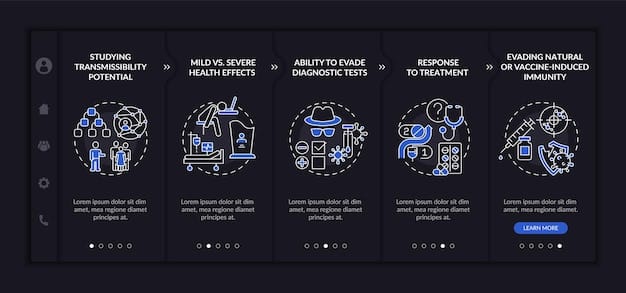CFATS Updates: Potential Impacts on Chemical Facility Anti-Terrorism Standards

The potential impacts of the proposed Chemical Facility Anti-Terrorism Standards (CFATS) updates are far-reaching, aiming to enhance the security posture of high-risk chemical facilities across the United States through revised regulatory frameworks, technological integration, and a focus on resilience against evolving threats.
As the landscape of national security evolves, so too must the regulatory frameworks designed to protect critical infrastructure. The proposed updates to the Chemical Facility Anti-Terrorism Standards (CFATS) represent a significant pivot in how the United States approaches the security of its diverse chemical facilities. This proactive step aims to fortify defenses against emerging threats, but what are the direct and indirect impacts these changes could usher in?
Understanding the CFATS Framework and Its Evolution
The Chemical Facility Anti-Terrorism Standards (CFATS) program, administered by the Department of Homeland Security (DHS), was established in 2007. Its primary goal was to identify and regulate facilities that possess or use chemicals of interest (COI) at or above specific threshold quantities, thereby preventing them from being exploited for terrorist purposes. This foundational framework has served as a cornerstone of U.S. critical infrastructure protection, evolving over time to address new challenges and technological advancements.
Initially, CFATS introduced a tiered risk assessment system, categorizing facilities based on the potential consequences of a chemical release or theft. Facilities were then required to develop and implement site-specific security plans tailored to their identified risk level. These plans encompassed a range of security measures, from physical barriers and access control to cybersecurity protocols and personnel screening. The program aimed to be dynamic, allowing for adjustments as threat landscapes shifted.
Key Components of the Original CFATS Program
The initial CFATS regulations laid out a comprehensive set of requirements for covered facilities. These were designed to create a layered defense, emphasizing both preventive and responsive measures. The program’s effectiveness relied heavily on collaboration between the DHS and regulated facilities, fostering a shared responsibility for national security.
- Risk Assessment: Facilities self-identified and reported chemicals of interest, leading to a DHS-assigned risk tier.
- Security Plan Development: Mandated the creation of Site Security Plans (SSPs) detailing specific security measures.
- Performance-Based Standards: Focused on achieving security outcomes rather than prescribing specific technologies.
- Inspection and Compliance: Regular inspections by DHS personnel to ensure adherence to SSPs and regulations.
Over the years, the CFATS program demonstrated its utility in securing thousands of chemical sites. However, its implementation also highlighted areas for potential improvement, particularly in adapting to rapidly evolving threats like sophisticated cyber-attacks and new modes of terrorist operations. The proposed updates are a direct response to these identified gaps, aiming to enhance the program’s agility and efficacy.
The impetus for these updates stems from a combination of factors: lessons learned from past incidents, advancements in security technologies, and a deeper understanding of the motivations and capabilities of potential adversaries. By continuously refining the regulatory framework, the DHS seeks to maintain a robust and adaptable security posture, ensuring that the CFATS program remains effective in a complex and ever-changing global security environment.
Enhanced Security Measures and Their Implementation
The core of the proposed CFATS updates revolves around the introduction of enhanced security measures, designed to further fortify chemical facilities against a broader spectrum of threats. These changes aim to move beyond traditional physical security, incorporating advanced technologies and more granular operational requirements. The implementation of these measures will necessitate significant adjustments for many regulated entities, impacting resource allocation and operational procedures.
One primary area of focus is the integration of advanced surveillance and detection systems. This includes not only more sophisticated perimeter monitoring but also internal detection capabilities to identify unauthorized access or suspicious activities within the facility. The goal is to provide real-time situational awareness, allowing for rapid response to potential security breaches. Facilities may be required to upgrade existing systems or invest in new technologies to comply with these elevated standards.
Technological Upgrades and Data Integration
The updates emphasize a greater reliance on interconnected security systems and data analytics. This means moving towards a more holistic security architecture where various components communicate and share information effectively. Facilities might need to invest in new software platforms and IT infrastructure to support these integrated systems.
- Automated Access Control Systems: Moving beyond simple card readers to biometric authentication and real-time visitor tracking.
- Cybersecurity Enhancements: More stringent requirements for protecting operational technology (OT) and information technology (IT) networks that control critical plant processes.
- Threat Intelligence Sharing: Potentially new mechanisms for facilities to receive and act upon real-time threat intelligence from government agencies and industry partners.
Beyond technology, the proposed updates also touch upon personnel security and training. This could involve more rigorous background checks, enhanced security awareness training for all employees, and specialized training for security personnel. The human element remains a critical component of any security strategy, and ensuring adequately trained and vigilant staff is paramount.
The implementation phase poses a significant challenge for facilities. It requires not only financial investment but also a thorough understanding of the new regulations and how they apply to specific site operations. Many facilities will likely need to conduct comprehensive security assessments to identify gaps and develop detailed plans for addressing them. This process will require careful planning and coordination to minimize disruption to ongoing operations while ensuring timely compliance with the new standards.
The DHS is expected to provide detailed guidance and resources to assist facilities during this transition. However, the onus will largely be on the regulated entities to proactively engage with these updates, allocate necessary resources, and embark on the required modifications to their security postures.
Economic Implications and Compliance Costs
The introduction of updated CFATS regulations will inevitably carry significant economic implications for chemical facilities. While the ultimate goal is enhanced national security, achieving this will require substantial investment in new technologies, infrastructure upgrades, and personnel training. Understanding these compliance costs is crucial for facilities to adequately prepare and budget for the forthcoming changes.
Firstly, direct capital expenditures will be a major factor. Facilities may need to purchase and install advanced surveillance cameras, biometric access control systems, enhanced perimeter lighting, and more robust cybersecurity hardware and software. These investments can range from tens of thousands to millions of dollars, depending on the size, complexity, and current security posture of a given facility.

Beyond one-time capital outlays, ongoing operational costs are also expected to rise. This includes increased maintenance fees for new security systems, higher utility costs for powering additional equipment, and potentially increased staffing for monitoring and responding to security incidents. The need for specialized cybersecurity professionals, for instance, could command higher salaries, adding to the operational budget.
Financial Burdens and Potential Mitigations
The financial burden may disproportionately affect smaller facilities with limited financial resources. Larger corporations might absorb these costs more easily, but smaller businesses could face significant challenges in meeting the new requirements without adequate support or incentives. This raises questions about potential government assistance or phased implementation strategies.
- Technology Procurement: Costs associated with acquiring and installing state-of-the-art security hardware and software.
- Personnel Training and Hiring: Expenses related to upskilling existing staff or recruiting new security and IT personnel.
- Consultancy and Auditing: Fees for third-party experts to assess compliance and assist with security plan development.
- Operational Adjustments: Potential changes to production schedules or increased downtime during security upgrades.
Furthermore, facilities will incur administrative costs related to documenting compliance, submitting reports to the DHS, and participating in ongoing inspections and audits. This administrative overhead, though often overlooked, can consume significant staff time and resources.
To mitigate some of these financial impacts, facilities might explore various strategies. These could include leveraging existing security infrastructure where possible, seeking government grants or tax incentives specifically designed for security enhancements, or adopting a phased approach to implementation that spreads costs over several fiscal years. Industry associations may also play a role in advocating for policies that ease the financial strain on their members, such as extended compliance deadlines or direct financial aid programs.
Ultimately, the economic impacts will vary widely among facilities, influenced by their current security maturity, the nature and quantity of their chemicals of interest, and their overall financial health. A transparent cost-benefit analysis will be essential for both regulators and regulated entities to ensure that the security enhancements are both effective and economically feasible.
Impact on Environmental and Safety Standards
The proposed CFATS updates, while primarily focused on anti-terrorism security, are intrinsically linked to environmental and safety standards within chemical facilities. Any modification to security protocols at sites handling hazardous materials inevitably has repercussions for occupational safety, emergency preparedness, and environmental protection. These interconnected domains mean that security enhancements must be carefully integrated to avoid unintended negative consequences or to identify opportunities for synergistic improvements.
One potential impact is a reinforced emphasis on inherent safety and security. By reducing the quantity of chemicals of interest on-site (through process changes or inventory management) or by using less hazardous alternatives, facilities can simultaneously reduce their risk profile for both accidental releases and intentional acts of terrorism. The updated standards might implicitly or explicitly encourage such approaches, leading to broader improvements in process safety management.
Synergies and Potential Conflicts with Existing Regulations
The updates present an opportunity to harmonize security measures with existing environmental and safety regulations, such as those governed by the Environmental Protection Agency (EPA) or the Occupational Safety and Health Administration (OSHA). For example, enhanced access control systems designed for security can also prevent unauthorized personnel from entering hazardous areas, thereby improving workplace safety.
- Emergency Response Planning: Security breaches can escalate into environmental incidents; improved security measures can thus enhance initial response capabilities.
- Information Sharing: Secure channels established for threat intelligence could also be utilized for sharing critical safety alerts or environmental monitoring data.
- Auditing and Compliance Overlap: Streamlining audits for both security and environmental regulations could reduce administrative burdens.
Conversely, there is a need to ensure that new security measures do not inadvertently impede safety procedures or emergency access. For instance, overly restrictive access protocols could delay emergency responders or hinder swift evacuation in the event of an internal incident. The design and implementation of physical security barriers, surveillance systems, and access controls must consider their impact on safety pathways and emergency procedures.
Moreover, the integration of new technologies, particularly in cybersecurity, requires careful consideration of their impact on industrial control systems (ICS) that manage critical safety functions. A robust cybersecurity posture enhances security, but vulnerabilities introduced by new systems could potentially disrupt operations and compromise safety integrity. Therefore, any cybersecurity upgrade must adhere to, and ideally enhance, existing process safety management systems.
Engagement with environmental and safety professionals during the planning and implementation phases of CFATS updates will be crucial. This interdisciplinary approach can ensure that security enhancements contribute positively to the overall safety culture and environmental stewardship of chemical facilities, rather than creating new challenges or conflicts with established best practices.
Cybersecurity and Information Security Enhancements
In an increasingly digital world, the proposed CFATS updates are set to place a significantly higher emphasis on cybersecurity and information security. Chemical facilities, like many critical infrastructure sectors, are highly reliant on interconnected digital systems for operation, monitoring, and control. Protecting these systems from cyber threats is no longer just an IT concern but a fundamental component of physical security and anti-terrorism defense. The updates recognize that a compromised digital system can be as devastating as a physical breach.
The enhanced requirements will likely mandate more rigorous cybersecurity protocols for both information technology (IT) and operational technology (OT) systems. OT systems, which control industrial processes, are particularly vulnerable as they often predate modern cybersecurity considerations and are challenging to update without disrupting operations. Facilities will need to implement stronger network segmentation, intrusion detection systems, and advanced endpoint protection.
Key Areas of Cybersecurity Focus
The updates will require a comprehensive approach to cybersecurity, moving beyond basic firewalls to advanced threat detection, incident response planning, and continuous monitoring. This shift acknowledges the evolving sophistication of cyber adversaries.
- Regular Vulnerability Assessments: Mandatory periodic scans and penetration testing to identify weaknesses in IT and OT networks.
- Incident Response Plans: Development of detailed protocols for detecting, responding to, and recovering from cyberattacks that could impact security of chemicals.
- Supply Chain Security: Scrutiny of the security practices of third-party vendors and suppliers whose systems may connect to facility networks.
- Employee Training: Enhanced awareness training for all staff on cybersecurity best practices, phishing, and social engineering threats.
Furthermore, information security extends to the protection of sensitive data related to facility operations, security plans, and chemical inventories. Unauthorized access to such information could provide adversaries with critical intelligence, making a facility more vulnerable. Enhanced encryption, access controls, and data loss prevention measures will be critical components of the updated standards.
The implementation of these cybersecurity enhancements presents unique challenges. The specialized nature of OT systems often means a shortage of skilled cybersecurity professionals with expertise in industrial control environments. Facilities may need to invest heavily in training existing staff or recruiting highly specialized talent. The integration of new security technologies into legacy systems also requires careful planning to avoid operational disruptions.
Compliance with these new cybersecurity standards will require a fundamental shift in how some facilities view and manage their digital assets. It moves cybersecurity from a supporting IT function to a core security imperative, requiring top-level management engagement and significant resource allocation. The aim is to create a resilient digital environment that can withstand sophisticated cyberattacks and protect against the malicious exploitation of industrial control systems for terrorist purposes.
Training, Preparedness, and Workforce Development
The effectiveness of any security framework, no matter how technologically advanced, ultimately hinges on the caliber of its workforce. The proposed CFATS updates are expected to place a significant emphasis on training, preparedness drills, and ongoing workforce development. This holistic approach ensures that personnel are not only aware of new protocols but are also equipped with the skills and knowledge to effectively implement them and respond to diverse security threats.
Firstly, the updates will likely necessitate revised and expanded security training programs for all employees, not just dedicated security personnel. Every individual working within or accessing a chemical facility has a role to play in its overall security posture. This could include enhanced awareness of insider threat indicators, reporting suspicious activities, and understanding emergency response procedures specific to security incidents.
Developing a Resilient Security Culture
Beyond basic awareness, specialized training will be crucial for personnel directly involved in security operations and system management. This includes security guards, IT and OT specialists, and emergency responders. The goal is to develop a highly competent and adaptable security workforce capable of responding to evolving threats and managing complex security technologies.
- Scenario-Based Drills: Regular exercises simulating various security incidents to test response plans and personnel readiness.
- Cross-Functional Training: Encouraging collaboration and understanding between different departments (e.g., security, operations, IT) during drills and real incidents.
- Cybersecurity Skill Development: Training for IT/OT staff on advanced threat detection, incident response, and secure system configuration.
- Awareness Programs: Continuous education for all employees on the latest security risks and best practices.
The concept of “preparedness” will extend beyond merely having a written plan. The updates may mandate more frequent and realistic drills and exercises, involving both internal personnel and external emergency responders. These drills allow facilities to identify gaps in their plans, refine communication protocols, and ensure that personnel can execute their roles effectively under pressure. Learning from these exercises will be critical for continuous improvement.
Workforce development also involves addressing the skills gap prevalent in many industrial sectors. As security technologies become more sophisticated, there is a growing demand for individuals with expertise in areas like industrial cybersecurity, forensic analysis, and advanced surveillance system management. Facilities may need to invest in vocational training programs, partnerships with academic institutions, or recruitment initiatives to attract and retain the necessary talent.
Furthermore, establishing a strong security culture within a facility is paramount. This means fostering an environment where security is everyone’s responsibility, and employees feel empowered to report concerns without fear of reprisal. Cultural shifts often take time and require consistent leadership commitment, but they are fundamental to creating a truly resilient security posture. The proposed CFATS updates aim to drive this cultural transformation alongside technological and procedural changes.
Regulatory Oversight and Future Adaptability
The proposed CFATS updates are not merely a one-time adjustment but are designed to enhance the program’s long-term regulatory oversight and future adaptability. In a rapidly changing threat environment, static regulations quickly become obsolete. The DHS aims to create a framework that can flexibly respond to new threats, technological advancements, and lessons learned from security incidents, ensuring the program remains effective for years to come.
One key aspect of enhanced oversight will likely be more frequent and detailed compliance inspections. These inspections will go beyond merely verifying the existence of security plans, delving deeper into the effectiveness of implemented measures and the training levels of personnel. The DHS may also leverage data analytics and remote monitoring capabilities to gain a more continuous understanding of a facility’s security posture, moving towards a more proactive rather than reactive oversight model.
Mechanisms for Continuous Improvement
The updates are expected to include provisions for regular review and revision of the standards themselves. This iterative process ensures that the CFATS program does not lag behind emerging threats or advancements in security best practices. Public comment periods and industry feedback mechanisms will be crucial for this ongoing adaptation.
- Periodic Standard Reviews: Mandated assessments of the CFATS regulations to ensure relevance and effectiveness against evolving threats.
- Performance Metrics and Data Sharing: Collection of data on security incidents and near-misses to inform future regulatory adjustments.
- Threat Landscape Assessments: Continuous evaluation of global and domestic terrorist threats to adjust security priorities and requirements.
- Technological Scouting: Proactive identification and evaluation of new security technologies that could be incorporated into future standards.
Furthermore, the updates may introduce more structured mechanisms for information sharing between the DHS, other government agencies, and regulated facilities. Timely and actionable threat intelligence is critical for preventing attacks. A more robust information-sharing framework could empower facilities to implement targeted protective measures based on the latest threat assessments, enhancing their ability to adapt quickly.
The challenge for regulatory bodies will be to strike a balance between providing clear guidance and allowing for the flexibility needed for facilities to implement performance-based security measures. Overly prescriptive regulations can stifle innovation, while overly vague ones can lead to inconsistent compliance. The aim is a framework that sets high standards while encouraging facilities to adopt the most effective and efficient solutions for their unique circumstances.
Ultimately, the proposed CFATS updates aim to build a more resilient and adaptable security ecosystem for chemical facilities. By focusing on continuous improvement, enhanced oversight, and collaborative information sharing, the program seeks to remain a vital shield against terrorism, capable of evolving as the threats themselves evolve. This forward-looking approach is essential for maintaining national security in an unpredictable world.
| Key Impact Area | Brief Description |
|---|---|
| 📊 Economic Burden | Increased costs for technology, training, and ongoing compliance for chemical facilities. |
| 🛡️ Enhanced Security | Stricter physical, cyber, and personnel security measures to mitigate evolving threats. |
| ⚙️ Operational Changes | Adjustments to facility operations, process safety, and emergency response protocols. |
| 💡 Adaptability for Future | Framework designed for continuous improvement and responsiveness to emerging threats. |
Frequently Asked Questions About CFATS Updates
▼
The CFATS standards are being updated to address the evolving threat landscape, incorporate lessons learned from past incidents, and integrate advancements in security technologies. This ensures the program remains effective in preventing chemical facilities from being exploited for terrorist purposes amidst new challenges.
▼
The primary focus of the new security measures extends beyond physical security to include enhanced cybersecurity protocols for both IT and operational technology (OT) systems. It also emphasizes advanced surveillance, detection, and personnel screening to create a more comprehensive defense.
▼
Yes, the updates are expected to increase costs for chemical facilities due to investments in new technologies, infrastructure upgrades, and enhanced training programs. The financial impact will vary based on a facility’s current security posture and scale of operations.
▼
The updates are intrinsically linked to environmental and safety standards. While primarily security-focused, they can lead to improved process safety and emergency preparedness. However, careful integration is needed to ensure security measures do not inadvertently impede safety procedures or emergency access.
▼
Workforce development is crucial. The updated CFATS emphasizes enhanced training, regular drills, and continuous skill development for all employees. This ensures personnel are equipped to implement new protocols, manage advanced technologies, and respond effectively to evolving security threats, fostering a resilient security culture.
Conclusion
The proposed updates to the Chemical Facility Anti-Terrorism Standards (CFATS) represent a critical and necessary evolution in safeguarding the nation’s high-risk chemical facilities. These changes are designed to fortify defenses against an increasingly sophisticated array of threats, demanding a proactive and comprehensive approach from regulated entities. While the implementation will undoubtedly bring economic considerations and require significant operational adjustments, the long-term benefits of enhanced security, improved resilience, and a more adaptable regulatory framework are paramount for national security. The success of these updates will ultimately hinge on the collaborative efforts between government oversight and the diligent commitment of the chemical industry to embrace and integrate the new standards, fostering a safer and more secure environment for all. It marks a significant step towards a more resilient and forward-looking approach to critical infrastructure protection.





